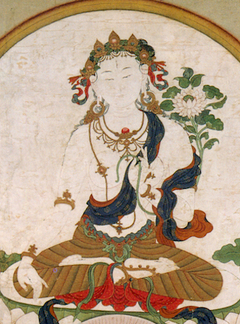Concise White Tārā Sādhana
༄༅། །སྒྲོལ་དཀར་སྒྲུབ་ཐབས་ཉུང་ངུ་བཞུགས། །
Concise White Tārā Sādhana
by Jamyang Khyentse Chökyi Lodrö
སངས་རྒྱས་ཆོས་དང་སོགས་ལན་གསུམ།
Recite “Sangyé chö dang...” three times:
སངས་རྒྱས་ཆོས་དང་ཚོགས་ཀྱི་མཆོག་རྣམས་ལ། །
sangye chö dang tsok kyi chok nam la
In the Buddha, the Dharma and the Supreme Assembly
བྱང་ཆུབ་བར་དུ་བདག་ནི་སྐྱབས་སུ་མཆི། །
changchub bardu dak ni kyab su chi
I take refuge until I attain enlightenment.
བདག་གི་སྦྱིན་སོགས་བགྱིས་པའི་བསོད་ནམས་ཀྱིས། །
dak gi jin sok gyipé sönam kyi
Through the merit of practising generosity and so on,
འགྲོ་ལ་ཕན་ཕྱིར་སངས་རྒྱས་འགྲུབ་པར་ཤོག
dro la pen chir sangye drubpar shok
May I attain buddhahood for the benefit of all beings.
ཨོཾ་སྭ་བྷཱ་ཝ་སོགས་ཀྱིས་སྟོང་པར་སྦྱངས།
Purify in emptiness with Oṃ svabhāva… etc.
ཨོཾ་སྭ་བྷཱ་ཝ་ཤུདྡྷོ་སརྦ་དྷརྨ་སྭ་བྷཱ་ཝ་ཤུདྡྷོ྅ཧཾ།
om sobhawa shuddho sarwa dharma sobhawa shuddho hang
oṃ svabhāva śuddhāḥ sarvadharmāḥ svabhāva śuddho ‘haṃ
སྟོང་པའི་ངང་ལས་པད་ཟླའི་སྟེང་། །
tongpé ngang lé pé dé teng
Out of the state of emptiness, upon a lotus and moon,
ཏཱྃ་ཡིག་དཀར་པོ་ཡོངས་གྱུར་ལས། །
tam yik karpo yong gyur lé
Through the transformation of a white syllable tāṃ,
རང་ཉིད་རྗེ་བཙུན་སྒྲོལ་མ་དཀར། །
rangnyi jetsün drolma kar
I become the noble White Tārā,
ཞལ་གཅིག་ཕྱག་གཉིས་གཡས་མཆོག་སྦྱིན། །
zhal chik chak nyi yé chok jin
With one face and two hands—the right in the mudrā of supreme giving
གཡོན་པས་སྐྱབས་སྦྱིན་ཨུཏྤལ་བསྣམས། །
yönpé kyab jin utpal nam
And the left granting protection and holding a lotus.
ཞི་འཛུམ་ཟླ་བའི་རྒྱབ་ཡོལ་ཅན། །
zhi dzum dawé gyab yolchen
She smiles serenely, with a moon behind her,
དར་དང་རིན་ཆེན་རྒྱན་གྱིས་སྤྲས། །
dar dang rinchen gyen gyi tré
And is bedecked in silk and jewel ornaments.
སྣང་ལ་རང་བཞིན་མེད་པར་གསལ། །
nang la rangzhin mepar sal
Although appearing clearly she is insubstantial.
གནས་གསུམ་ཨོཾ་ཨཱཿཧཱུྃ་གསུམ་དང་། །
né sum om ah hung sum dang
At her three centres are the three syllables oṃ āḥ hūṃ,
ཐུགས་དབུས་ཟླ་སྟེང་ཏཱྃ་དཀར་པོ། །
tuk ü da teng tam karpo
And in the centre of her heart upon a moon is a white tāṃ,
འོད་འཕྲོས་ཡེ་ཤེས་སྤྱན་དྲངས་གྱུར། །
ö trö yeshe chendrang gyur
From which light shoots out to invite the wisdom being,
ཛཿཧཱུྃ་བཾ་ཧོཿགཉིས་མེད་ཐིམ། །
dza hung bam ho nyimé tim
Who dissolves indivisibly through jaḥ hūṃ baṃ hoḥ.
དབང་ལྷ་སྤྱན་དྲངས་དབང་བསྐུར་ཞིང་། །
wanglha chendrang wangkur zhing
Empowerment deities, once invoked, confer empowerment,
ཆུ་ལྷག་གྱེན་དུ་འཁྱིལ་བ་ལས། །
chu lhak gyendu khyilwa lé
And the leftover water swirls upwards,
འོད་དཔག་མེད་ཀྱིས་དབུར་བརྒྱན་གྱུར། །
öpakmé kyi urgyen gyur
So that Amitābha adorns her crown.
ཐུགས་ཀར་ཟླ་བའི་རང་བཞིན་གྱི། །
tukkar dawé rangzhin gyi
At her heart is a white wheel, the nature of the moon,
འཁོར་ལོ་དཀར་པོ་རྩིབས་བརྒྱད་དབུས། །
khorlo karpo tsib gyé ü
With eight spokes; in its centre is a taṃ
ཏཱྃ་དང་རྩིབས་ལ་འབྲུ་བརྒྱད་གསལ། །
tam dang tsib la dru gyé sal
And on the spokes eight syllables clearly appear.
འོད་འཕྲོས་འཕགས་མཆོད་བྱིན་རླབས་བསྡུས། །
ö trö pak chö jinlab dü
Light radiates out, makes offerings to the noble ones, collects their blessings,
ཁྱད་པར་འཁོར་འདས་ཚེ་བཅུད་རྣམས། །
khyepar khordé tsechü nam
And gathers the vital essence of saṃsāra and nirvāṇa in particular
འོད་ཟེར་བདུད་རྩིའི་རྣམ་པས་དྲངས། །
özer dütsi nampé drang
In the form of nectar and rays of light,
ཐུགས་ཀའི་འཁོར་ལོར་ཐིམ་པ་དང་། །
tukké khorlor timpa dang
All of which dissolves into the wheel at my heart,
དེ་ལས་བདུད་རྩིའི་རྒྱུན་བབས་པས། །
dé lé dütsi gyün babpé
From which a stream of nectar flows out to fill my body
ལུས་གང་དུས་མིན་འཆི་བ་སྦྱངས། །
lü gang dümin chiwa jang
And wash away the potential for untimely death,
ཚེ་ཡི་དངོས་གྲུབ་ཐོབ་པར་བསམས།
tsé yi ngödrub tobpar sam
So that I gain the siddhi of long life.
ཨོཾ་ཏཱ་རེ་ཏུཏྟཱ་རེ་ཏུ་རེ་སྭཱ་ཧཱ།
om taré tuttaré turé soha
oṃ tāre tuttāre ture svāhā
ཡི་གེ་བཅུ་པ་དང་།
Recite this ten-syllable mantra and:
ༀ་ཏཱ་རེ་ཏུཏྟཱ་རེ་ཏུ་རེ་མཱ་མཱ་ཨཱ་ཡུར་པུཎྱེ་ཛྙཱ་ན་པུཥྚིཾ་ཀུ་རུ་སྭཱ་ཧཱ།
om taré tuttaré turé mama ayur punyé jnana pushting kuru soha
oṃ tāre tuttāre ture mama āyur puṇya jñāna puṣṭiṃ kuru svāhā
ཐུན་མཐར།
At the end of the session:
རྗེ་བཙུན་བཅོམ་ལྡན་འདས་མ་ཡིས། །
jetsün chomden dema yi
Precious noble lady, transcendent conqueror,
བདག་སོགས་དུས་མིན་འཆི་བ་སྦྱངས། །
dak sok dümin chiwa jang
Purify untimely death for me and other beings,
འཆི་མེད་ཚེ་དང་ཡེ་ཤེས་ཀྱི། །
chimé tsé dang yeshe kyi
And grant us the blessings and attainments
བྱིན་རླབས་དངོས་གྲུབ་སྩལ་དུ་གསོལ། །
jinlab ngödrub tsal du sol
Of immortal life and wisdom.
ལྷར་སྣང་འོད་གསལ་དབྱིངས་སུ་ཐིམ། །
lhar nangö sal ying su tim
The deity appearances dissolve into the space of clear light,
ཟབ་ཞི་སྤྲོས་བྲལ་ངང་དུ་བཞག །
zab zhi trödral ngang du zhak
And I rest in a state of profound peace beyond complexity.
སླར་ཡང་རང་ཉིད་སྒྲོལ་མའི་སྐུར། །
lar yang rangnyi drolmé kur
Once again, I arise in the form of Tārā,
ལམ་གྱིས་གསལ་བའི་གནས་གསུམ་དུ། །
lam gyi salwé né sum du
Brilliantly vivid and marked with the three syllables
ཨོྃ་ཨཱཿཧཱུྃ་གིས་མཚན་པར་གྱུར། །
om ah hung gi tsenpar gyur
Oṃ āḥ hūṃ at my three centres.
དགེ་བ་འདི་ཡིས་སོགས་ཀྱིས་དགེ་བསྔོ་བྱའོ། །
Dedicate with “Through this virtue…etc.”
དགེ་བ་འདི་ཡིས་མྱུར་དུ་བདག །
gewa di yi nyurdu dak
Through the positivity and merit of this, may I swiftly
རྗེ་བཙུན་སྒྲོལ་མ་འགྲུབ་གྱུར་ནས། །
jetsün drolma drub gyur né
Attain the realization of Noble Tārā, and thereby
འགྲོ་བ་གཅིག་ཀྱང་མ་ལུས་པ། །
drowa chik kyang malüpa
Every single sentient being
དེ་ཡི་ས་ལ་འགོད་པར་ཤོག །
dé yi sa la göpar shok
Reach her state of perfection too.
ཞེས་པའང་རྡོ་གྲུབ་བླ་མ་བསྟན་འཛིན་གྱི་ཁ་ཏོན་དུ་ཆོས་ཀྱི་བློ་གྲོས་པས་སོ།། །།
Chökyi Lodrö composed this for the recitation of Dodrup Lama Tendzin.
| Translated by Adam Pearcey with the generous support of the Khyentse Foundation and Tertön Sogyal Trust, 2020.
Source:
'Jam dbyangs chos kyi blo gros. "sgrol dkar gyi sgrub thabs nyung bsdus/" in ’Jam dbyangs chos kyi blo gros kyi gsung ’bum. 12 vols. Bir: Khyentse Labrang, 2012. W1KG12986 Vol. 7: 273–274
Version: 1.2-20250218
